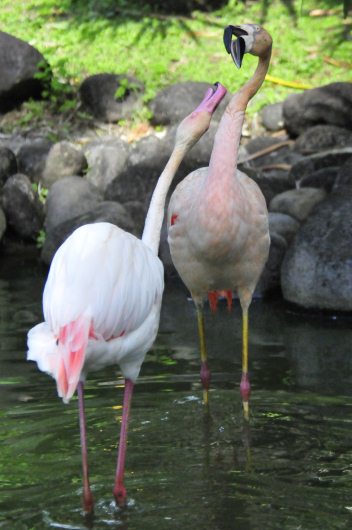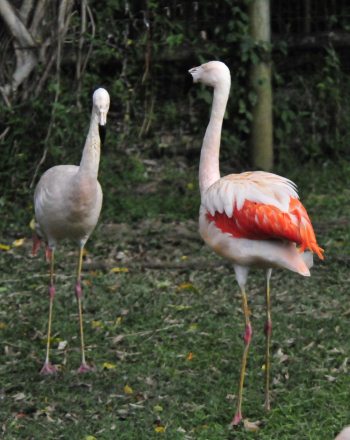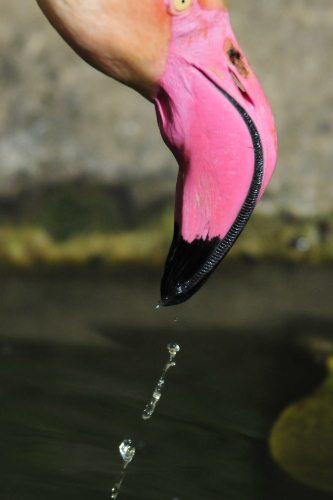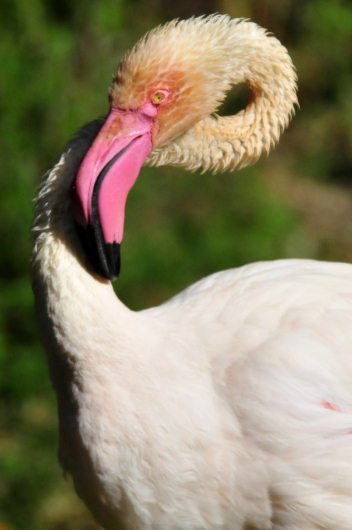Flamingos

|
Flamingos
 We stood for ages watching these odd looking creatures in the Botanical Gardens, we got the giggles when, head under water they dance round, like some demented aerobics class. Flamingos or flamingoes are gregarious wading birds in the genus Phoenicopterus, the only genus in the family Phoenicopteridae. There are four flamingo species in the Americas and two species in the Old World.
 
Species: Six flamingo species are recognised by most sources, and these are generally placed in one genus, Phoenicopterus. The Greater Flamingo is found in parts of Africa, Europe and Asia – the most widespread. The Lesser Flamingo lives in Africa and northwest India – the most numerous. The Chilean Flamingo lives is temperate South America. The American Flamingo is found in the Caribbean and the Galapagos Islands (hope to see him). The James’s and Andean Flamingos are found in the High Andes in Peru, Chile, Bolivia and Argentina (the ones that surprised us so living at twelve thousand feet next to the Andean coot, duck and others.
  Fossil records: Flamingoes are well attested in the fossil record, with the first unequivocal member of the extant family Phoenicopteridae, Elornis known from the Late Eocene. A considerable number of little-known birds from the Late Cretaceous onwards are sometimes considered to be flamingo ancestors. An extinct family of peculiar "swimming flamingos", the Palaelodidae, are believed to be related to, or to be the ancestors of, the modern flamingos. This is sometimes rejected, since the fossil Elornis is known to be from some time before any palaelodid flamingos have been recorded. There exists a fairly comprehensive fossil record of the genus Phoenicopterus.
 
Relations: The identity of the closest relatives of the flamingos is a rather contentious issue. A wide variety of birds have been proposed as their closest relatives, on a wide variety of evidence. To reflect the uncertainty about this matter, flamingos are generally placed in their own order. Recent molecular and anatomical studies have suggested a relation with grebes. Genetic studies since 2004 have identified a major clade of birds, which has been named the Metaves. This group includes flamingos and grebes, as well as the hoatzin, pigeons, hummingbirds and the sunbittern. Most of these groups have been difficult to place on the family tree of birds. Relations within this group are somewhat unclear, and it has been suggested that this clade is based on molecular convergence. I can live with the grebe theory, but a relative of our mates, the hummingbird, with those legs I don't think so ???
 
The arcuate bill is well adapted to bottom scooping Description: Flamingos often stand on one leg, the other tucked beneath the body. The reason for this behavior is not fully understood. Some suggest that the flamingo, like some other animals, has the ability to have half of its body go into a state of sleep, and when one side is rested, the flamingo will swap legs and then let the other half sleep, but this has not been proven. Recent research has indicated that standing on one leg may allow the birds to conserve more body heat, given that they spend a significant amount of time wading in cold water. As well as standing in the water, flamingos may stamp their webbed feet in the mud to stir up food from the bottom. Young flamingos hatch with grey plumage, but adults range from light pink to bright red due to aqueous bacteria and beta carotene obtained from their food supply. A well-fed, healthy flamingo is more vibrantly coloured and thus a more desirable mate; a white or pale flamingo, however, is usually unhealthy or malnourished. Captive flamingos are a notable exception; many turn a pale pink as they are not fed carotene at levels comparable to the wild. This is changing as more zoos begin to add prawns and other supplements to the diets of their flamingos.

Behaviour: Flamingos filter-feed on brine shrimp and blue-green algae. Their oddly shaped beaks are specially adapted to separate mud and silt from the food they eat, and are uniquely used upside-down. The filtering of food items is assisted by hairy structures called lamellae which line the mandibles, and the large rough-surfaced tongue. The pink or reddish color of flamingos comes from carotenoid proteins in their diet of animal and plant plankton. These proteins are broken down into pigments by liver enzymes. The source of this varies by species, and affects the saturation of color. Flamingos whose sole diet is blue-green algae are darker in color compared to those who get it second hand (e.g. from animals that have digested blue-green aglae). Zoo-fed flamingos, who often lack the color enhancer in their diet, may be given food with the additive canthaxanthin. Flamingos produce a crop milk, like pigeons and doves, due to the action of a hormone called prolactin. It contains more fat and less protein than the latter does, and it is produced in glands lining the whole of the upper digestive tract, not just the crop. Both parents nurse their chick, and young flamingos feed on this milk, which also contains red and white blood cells, for about two months until their bills are developed enough to filter feed.
  Conservation status: Scientists have discovered that flamingos are dying by the thousands along the Great Rift Valley lakes of Kenya and Tanzania. However, they are baffled as to the reason. Possible causes include avian cholera, botulism, metal poisoning, pesticides or poisonous bacteria, say researchers. Also, fears for the future of the Lesser Flamingo - Phoeniconaias minor - have been raised by plans to pipe water from one of their key breeding areas, the shores of Lake Natron. The lakes are crucial to the birds' breeding success because the flamingos feed off the blooms of cyanobacteria that thrive there.
  In captivity: The first flamingo hatched in a European zoo was a Chilean Flamingo at Zoo Basel in 1958. Since then, over three hundred and eighty nine flamingos grew up in Basel and were distributed to other zoos around the globe.
 Relationship with humans: In Ancient
Rome, flamingo tongues were considered a delicacy. Also, Andean miners have killed flamingos for their fat, believed to
be a cure for tuberculosis. Ancient
Egyptians believed flamingos to be the living representation of the god
Ra. The Moche people of ancient Peru worshipped nature. They placed emphasis on animals and often
depicted flamingos in their art. Pink plastic
flamingo statues are popular lawn
ornaments in the United
States – no comment, but we may need to buy
one.
 ALL IN ALL SUCH
COMEDIANS
|





